| Pages:
1
2 |
Magpie
lab constructor
    
Posts: 5939
Registered: 1-11-2003
Location: USA
Member Is Offline
Mood: Chemistry: the subtle science.
|
|
Preparation of Nitric Acid
Preparation of Nitric Acid
by Magpie
12/2/09
Introduction
This procedure is for the preparation of 125 mL of azeotropic (68wt%) nitric acid using Rooto sulfuric acid and pottery grade KNO3.
KNO3 + H2SO4 = KHSO4 + HNO3
CAUTION Toxic NO2 is generated during the early stage of this procedure. Therefore it must be done outside or in an efficient fume
hood.
Procedure
A. Reagent Preparation
Weigh out 225g of KNO3 in a beaker, crushing any lumps to attain a uniform powder. Set aside.
In a separate beaker carefully add 100mL of Rooto sulfuric acid (96wt% H2SO4) to 48 mL of water with stirring. The beaker should be cooled in a
container of cold water during the addition of the acid.
B. Equipment Set-Up
Place a 500mL round bottom flask (RBF) as pot in a simple distillation set-up using a 250 mL RBF receiver. Seal all ground-glass joints with a thin
coat of silicone grease. Place a Claisen adapter between the pot and the distillation adapter as shown in the photo below. This is to mitigate any
foaming. Insert a plug in the unused short Claisen port. Install joint clamps at all joints except that for the plug. The plug will serve as a
pressure relief port in the event of a pluggage. Provide cold water (or ice water) to the condenser.
Place the pot on a 500mL, 270 watt Glas-Col mantle (or equivalent). Install a thermometer capable of reaching 120°C in the distillation adapter.
Use of a PTFE thermometer adapter is recommended as rubber is attacked by hot nitric acid vapors. If necessary the thermometer could be omitted and
replaced by a plug.
Temporarily remove the pot and add the diluted acid prepared above. Using a powder funnel add the KNO3. Occasionally stir by swirling and using a
stirring rod. A viscous mass will result. Reconnect the pot to the Claisen adapter and bring the heating mantle into position.
Wrap the pot with an insulated blanket. Wrap the Claisen adapter with fiberglass insulation.
C. Distillation
Turn on the cooling water. If using a hood, turn on the fan. Set the mantle at 70% of maximum power and turn on.
As the system heats up it will first fill with brown NO2 gas. This will escape through the vacuum adapter port. A piece of Tygon tubing attached to
this port to direct the flow of NO2 away from the cooling water rubber hoses is recommended. After a few minutes the generation of NO2 will cease.
The vapor temperature at the stillhead will reach and hold solid at 120°C.
A steady generation of 68% nitric acid will follow. Very little attention is needed until near the end of the distillation. At this time the Claisen
adapter will begin to fill with foam. Terminate the distillation at this time.
CAUTION
Excessive foam generation and saltcake carryover will likely plug the condenser. The safety relief plug will blow and saltcake will flow down over
the insulation and mantle. NO2 will escape out of the relief port. The product may become contaminated with saltcake.
Product
The receiver RBF should contain about 125mL of 68% nitric acid at the end of the distillation. It will be tainted brown with dissolved NO2. The
color will eventually disappear if the lid on the storage bottle is not too tight fitting.
References
1. "Preparation of Nitric Acid," by Eleusius
2. "Equal weights of 96% H2SO4 and NaNO3" from traditional recipes.
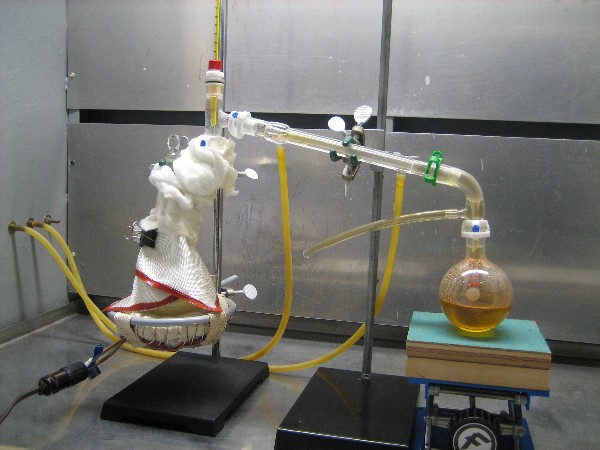
[Edited on 3-12-2009 by Magpie]
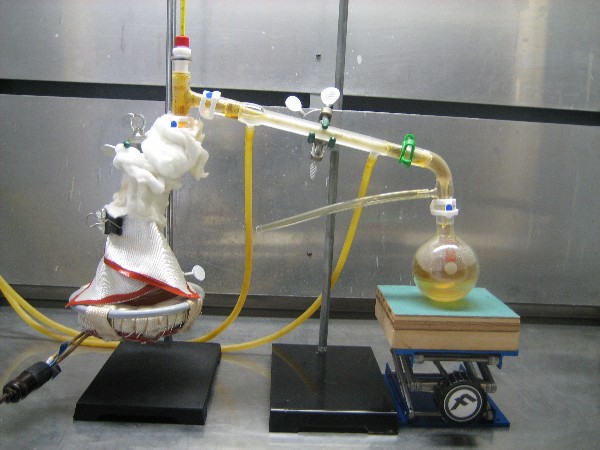
[Edited on 3-12-2009 by Magpie]
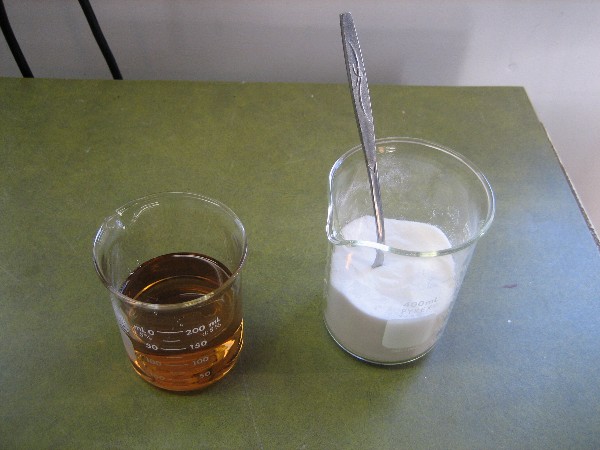
[Edited on 3-12-2009 by Magpie]
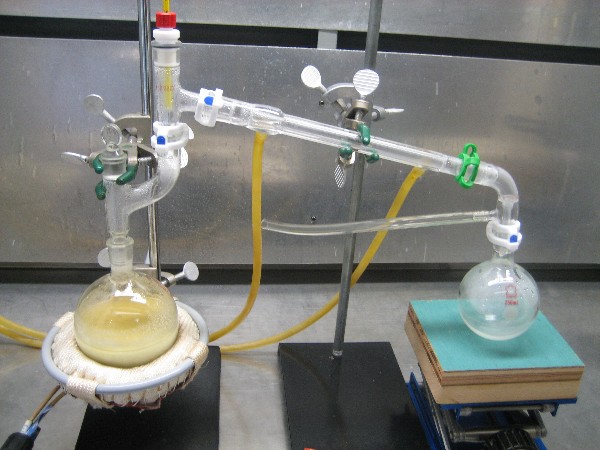
[Edited on 3-12-2009 by Magpie]
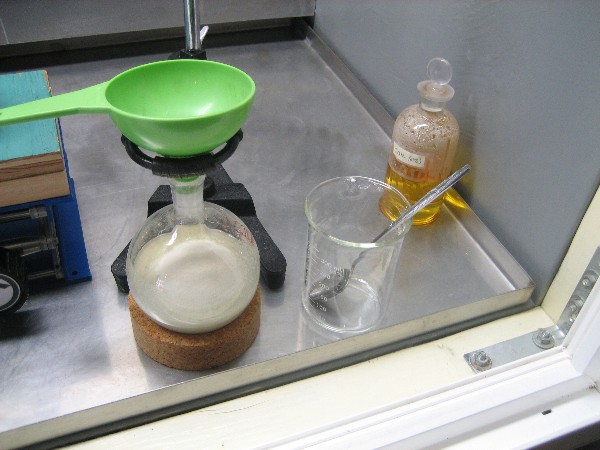
[Edited on 3-12-2009 by Magpie]
[Edited on 3-12-2009 by Magpie]
The single most important condition for a successful synthesis is good mixing - Nicodem
|
|
|
Aqua_Fortis_100%
Hazard to Others
  
Posts: 302
Registered: 24-12-2006
Location: Brazil
Member Is Offline
Mood: †
|
|
Magpie, do you tried to harvest and purify the saltcake KHSO4?
Its a interesting by-product since you could make other K salts.. Im interested in simple substances like K2CO3 and also in KOH, and here the only OTC
salts are KCl and KNO3(much less OTC).
One time I did this and found that was difficult, since I used concentrated acid without dillution and the resulting cake formed was a very hard mass,
dissolving it was difficult.
Nice pics, nice write-up.
Lovely yield of HNO3 
[Edited on 3-12-2009 by Aqua_Fortis_100%]
"The secret of freedom lies in educating people, whereas the secret of tyranny is in keeping them ignorant."
|
|
|
Magpie
lab constructor
    
Posts: 5939
Registered: 1-11-2003
Location: USA
Member Is Offline
Mood: Chemistry: the subtle science.
|
|
Thanks AF. No, I have not tried to recover the KHSO4. I'm not sure how pure it is; it may contain unreacted KNO3. The saltcake is, as you say, not
all that soluble. It seems to take a lot of hot water to wash the hard saltcake out of the RBF.
The single most important condition for a successful synthesis is good mixing - Nicodem
|
|
|
chemrox
International Hazard
    
Posts: 2961
Registered: 18-1-2007
Location: UTM
Member Is Offline
Mood: LaGrangian
|
|
A clarifying question: the 2% or so water in hardware store H2SO4 is sufficient to keep the mass from becoming too hard to still the HNO3 out? Could
one use reagent H2SO4 and add a small amount of water?
Another idea: use a two neck flask and rig a "downspout" with a gooseneck adapter with a female joint-cap over the end. Or an RB with a glasswool
plug between the down end of the adapter and the RB (?).
Last: anybody know what a literature version of this looks like?
"When you let the dumbasses vote you end up with populism followed by autocracy and getting back is a bitch." Plato (sort of)
|
|
|
Magpie
lab constructor
    
Posts: 5939
Registered: 1-11-2003
Location: USA
Member Is Offline
Mood: Chemistry: the subtle science.
|
|
Quote: Originally posted by chemrox  | | A clarifying question: the 2% or so water in hardware store H2SO4 is sufficient to keep the mass from becoming too hard to still the HNO3 out? Could
one use reagent H2SO4 and add a small amount of water? |
I have no experience doing this. I don't see why HNO3 of concentration higher than that of the azeotrope (68wt%) could not be produced that way,
however. I think others have done this. They may know the upper limit of H2SO4 "dryness," if any.
| Quote: |
Another idea: use a two neck flask and rig a "downspout" with a gooseneck adapter with a female joint-cap over the end. Or an RB with a glasswool plug
between the down end of the adapter and the RB (?). |
The advantage of the Claisen adapter is that it provides extra capacity for containing the foam before it reaches the condenser. In the condenser
the foam will solidify and plug the vent path.
I wouldn't trust a glass wool plug to contain hot nitric acid vapor, if that is what you mean.
The single most important condition for a successful synthesis is good mixing - Nicodem
|
|
|
thereelstory1
Harmless

Posts: 8
Registered: 12-4-2010
Member Is Offline
Mood: No Mood
|
|
please excuse me not knowing the answer to this:
so if you wanted to further purify the HNO3 from azeotrope to as close to 100 percent pure, how would you go about breaking up this azeotrope
effectively?
|
|
|
Magpie
lab constructor
    
Posts: 5939
Registered: 1-11-2003
Location: USA
Member Is Offline
Mood: Chemistry: the subtle science.
|
|
I don't know off-hand how you would do this. I suspect a different procedure should be used to make nitric acid of higher concentration than
azeotropic, ie, a procedure involving less water. Someone else can surely give you a better answer.
The single most important condition for a successful synthesis is good mixing - Nicodem
|
|
|
12AX7
Post Harlot
    
Posts: 4803
Registered: 8-3-2005
Location: oscillating
Member Is Offline
Mood: informative
|
|
I heard distill it from sulfuric a second time. Probably with vacuum.
Tim
|
|
|
Magpie
lab constructor
    
Posts: 5939
Registered: 1-11-2003
Location: USA
Member Is Offline
Mood: Chemistry: the subtle science.
|
|
Here's a NurdRage video showing how to make pure, or fuming, nitric acid. It's on the last part of the video.
http://www.youtube.com/watch?v=2yE7v4wkuZU
Here's a better one, more to the point of your question:
http://www.youtube.com/watch#!v=CtdX5YmOdcs&feature=rela...
[Edited on 18-4-2010 by Magpie]
The single most important condition for a successful synthesis is good mixing - Nicodem
|
|
|
mnick12
Hazard to Others
  
Posts: 404
Registered: 30-12-2009
Location: In the lab w/ Dr. Evil
Member Is Offline
Mood: devious
|
|
I have made RFNA a number of times, no vaccum needed. Simply distill a nitrate salt with conc H2SO4, so do what Magpie tells you to do at the
beginning of this thread but skip on the water.
|
|
|
thereelstory1
Harmless

Posts: 8
Registered: 12-4-2010
Member Is Offline
Mood: No Mood
|
|
thanks all of you. so, rooto is considered concentrated enough?
|
|
|
rrkss
Hazard to Others
  
Posts: 193
Registered: 18-12-2009
Member Is Offline
Mood: No Mood
|
|
Just ran your experiment as written. Did make nitric acid but upon titration I got 12 molar nitric acid and not the 15.8 molar of concentrated
reagent grade. Still made 52% nitric acid this way but I think when I run it again, I am going to reduce the amount of water to 34 mL to bring the
concentration of the distillate closer to 70%.
|
|
|
DJF90
International Hazard
    
Posts: 2266
Registered: 15-12-2007
Location: At the bench
Member Is Offline
Mood: No Mood
|
|
mnick12: You're right, you don't need a vacuum for making RFNA, but for WFNA, which is essentially as pure and concentrated a nitric acid you can get,
a vacuum is indespensible. Tim is correct on this issue; distillation of azeotropic nitric acid from an equal volume of concentrated sulfuric acid
under reduced pressure is what is needed to get as close to 100% WFNA as possible (tends to be ~95%+ HNO3.) - A second distillation would almost
indefinately get you to 99%+ I suspect.
|
|
|
Magpie
lab constructor
    
Posts: 5939
Registered: 1-11-2003
Location: USA
Member Is Offline
Mood: Chemistry: the subtle science.
|
|
Quote: Originally posted by rrkss  | | Just ran your experiment as written. Did make nitric acid but upon titration I got 12 molar nitric acid and not the 15.8 molar of concentrated
reagent grade. Still made 52% nitric acid this way but I think when I run it again, I am going to reduce the amount of water to 34 mL to bring the
concentration of the distillate closer to 70%. |
If you collected distillate before the still head temperature reached 120C then you would have a concentration less than 68%, assuming a slight
surplus of water. I probably should have clarified that in the procedure. As you say, cutting back on the water should correct that.
The single most important condition for a successful synthesis is good mixing - Nicodem
|
|
|
thereelstory
Harmless

Posts: 41
Registered: 18-1-2010
Member Is Offline
Mood: No Mood
|
|
so can you recycle the h2so4 once you have distilled the hno3? AND how much water would the concentrated h2so4 absorb from the hno3?
|
|
|
DJF90
International Hazard
    
Posts: 2266
Registered: 15-12-2007
Location: At the bench
Member Is Offline
Mood: No Mood
|
|
Well if you start at 68% and end up in the mid 90's, the the sulfuric must end up absorbing most of the water right? Doesn't take a genius to work it
out :/
|
|
|
Natures Natrium
Hazard to Others
  
Posts: 163
Registered: 22-12-2004
Member Is Offline
Mood: No Mood
|
|
Just followed the write-up here, with the following changes:
Used flat bottom flask on a stirring hot plate with a stir bar.
Changed reagent ratios from "1.86mol H2SO4 : 2.23 mol KNO3" to "2.25mol H2SO4 : 2.23mol KNO3"
Added another 20% water by volume. (58mL total).
Used a different brand of sulfuric acid, which had a density indicating 97% and which was a translucent amber color.
Used stump remover grade potassium nitrate.
The addition of the salt initially froze the stir bar. Upon heating the stir bar was able to resume, which caused a bit of mild bumping that ejected
a small quantity of salt into the condenser, but did not clog it. After that the distillation was smooth. It did however produce quite a large
quantity of NO2, and the acid collected was a deep orange. After several days, it is finally beginning to be more yellow than orange, although there
is still a visible atmosphere of NO2 in the bottle.
Fortunately, my fumehood (powered by a whole-house ventilation scroll fan) was just able to keep up. I didn't realize that this would produce so much
NO2, and should I ever repeat this I will definitely set up a gas scrubbing train.
The flask received around 100mL of liquid, but 5mL were left behind to keep the salt out of the storage flask. The 95mL that were recovered weighed
135.8g on a triple beam balance, for a density of 1.43g. This would seem to indicate a ~70% solution, although between dissolved NO2 and measurement
inaccuracies, 68% seems reasonable.
I also titrated 5mL of the above acid, mixed with 95mL of dH2O, with 1M NaOH (prepped by myself some weeks ago) and calculated a concentration of 60%.
This doesn't equate to the density data, and given the age of the 1M solution (kept in a quart mason jar), it seems likely that this titration is
inaccurate. I might repeat with a fresh batch of 1M NaOH at some point.
Overall it would seem that some or all of the modifications I made resulted in a lower yield despite using more reagents. Should there be a next
time, my plan is to follow the reagent ratios listed in this write-up more exactly.
As an aside, I poured 100mL dH20 into the reaction flask (the gaseous NO2 was absorbed very quickly), and plan on attempting to recover the KHSO4 at
some point.
\"The man who does not read good books has no advantage over the man who cannot read them.\" - Mark Twain (1835-1910)
|
|
|
smaerd
International Hazard
    
Posts: 1262
Registered: 23-1-2010
Member Is Offline
Mood: hmm...
|
|
I followed this preparation today using some sodium nitrate I made after generating ammonia gas from ammonium nitrate. Worked great, I have yellow
fuming nitric acid about 150mL or so.
I also plugged a thermometer adapter with teflon tape(plumbers tape) then fixed it down with some duct-tape. Held up perfectly fine, not that I
really recommend it.
Just wanted to report my findings and say thanks to magpie for this write-up.
|
|
|
binaryclock
Hazard to Others
  
Posts: 121
Registered: 9-4-2013
Location: Canada
Member Is Offline
Mood: Organic
|
|
Sorry to revive this thread, but it seems like a good one to continue this conversation.
Q: What would be a good scrubber setup for removing the toxic NO2 gases or the fuming from the acid gases when they exit the vent port? I don't use a
vacuum. Could a diluted 10% NaHO + H2O solution neutralize the gases if I hooked up a hose from my vacuum port? Also, I suppose my latex/rubber hose
wouldn't be good for this.. what type of hose would you suggest?
Thanks
Current Project: Playing with my new Laboy advanced distillery kit!
|
|
|
Bot0nist
International Hazard
    
Posts: 1559
Registered: 15-2-2011
Location: Right behind you.
Member Is Offline
Mood: Streching my cotyledons.
|
|
Bubbling through a hydroxide solution will scrub most of the acidic vapors, keep it cool. Vinyl or HDPE tubing will work fine, but it will get
corroded. If your condenser is very cool, and long enough, you shouldn't get to many acidic vapors on the exit end. Don"t overheat the mix either.
Distill in a place, where if the apparatus has a catastrophic failure (read: it all goes to shit, worse case scenario) you and your property will be
OK. Plan for contingencies, like a fire, a cracked flask, a RFNA spill and the escape of Noxious gasses. Proper ventilation (NOx will KILL you) and
fire mitigation is priority...
U.T.F.S.E. and learn the joys of autodidacticism!
Don't judge each day only by the harvest you reap, but also by the seeds you sow.
|
|
|
binaryclock
Hazard to Others
  
Posts: 121
Registered: 9-4-2013
Location: Canada
Member Is Offline
Mood: Organic
|
|
Thanks for your reply! I moved all the equipment up to my garage when distilling nitric. This way, if "it all goes to shit" then I can open up my
garage door and deal with it. I don't feel comfortable distilling nitric in my basement, even with a fume hood.
Current Project: Playing with my new Laboy advanced distillery kit!
|
|
|
RRMarsh
Unregistered
Posts: N/A
Registered: N/A
Member Is Offline
|
|
Thanks all for the insight. Got to know the appropriate procedure and concentration for each constituent.
|
|
|
Hellafunt
Hazard to Self
 
Posts: 65
Registered: 2-12-2014
Member Is Offline
Mood: No Mood
|
|
I recently switched to this method for producing nitric acid, and Im sure you guys don't need me to tell you that it works great. Last night ,
however, I ran into a slight problem. I was excited that I figured out a solution.
I had wrapped some heat proof pads around the top of the reaction flask and the Claisen adapter to keep it warm. Then I decided to let it run a
little longer than usual to try to get every last drop of nitric acid out. I knew there was some foaming going on towards the end, but I didn't
realize how much. Anyway, I ended up with my Liebig condenser completely clogged with the salt cake. Like a solid rock tube the whole length of the
inner glass tube.
Of course I tried to wash it out, and to gently chip away at it with metal implements of destruction. It seemed that I was going to break the
thing before too long. Then, I put it in the microwave for about 15 seconds and stood back. When I opened the microwave, the salt cake had mostly
liquefied and ejected itself from the inside, and the rest was easily washed out with hot water. What a relief. It is nice to be divorced and to be
able to use the microwave when needed.
|
|
|
Loptr
International Hazard
    
Posts: 1347
Registered: 20-5-2014
Location: USA
Member Is Offline
Mood: Grateful
|
|
Quote: Originally posted by Hellafunt  | I recently switched to this method for producing nitric acid, and Im sure you guys don't need me to tell you that it works great. Last night ,
however, I ran into a slight problem. I was excited that I figured out a solution.
I had wrapped some heat proof pads around the top of the reaction flask and the Claisen adapter to keep it warm. Then I decided to let it run a
little longer than usual to try to get every last drop of nitric acid out. I knew there was some foaming going on towards the end, but I didn't
realize how much. Anyway, I ended up with my Liebig condenser completely clogged with the salt cake. Like a solid rock tube the whole length of the
inner glass tube.
Of course I tried to wash it out, and to gently chip away at it with metal implements of destruction. It seemed that I was going to break the
thing before too long. Then, I put it in the microwave for about 15 seconds and stood back. When I opened the microwave, the salt cake had mostly
liquefied and ejected itself from the inside, and the rest was easily washed out with hot water. What a relief. It is nice to be divorced and to be
able to use the microwave when needed.
|
I was kicked out of the kitchen when I attempted to dry magnesium sulfate in the oven. 
|
|
|
Molecular Manipulations
Hazard to Others
  
Posts: 447
Registered: 17-12-2014
Location: The Garden of Eden
Member Is Offline
Mood: High on forbidden fruit
|
|
You could have just soaked it water, potassium sulfate and bisulfate are soluble, takes a while though. I wouldn't have thought of using the
microwave, nice.
-The manipulator
We are all here on earth to help others; what on earth the others are here for I don't know. -W. H. Auden
|
|
|
| Pages:
1
2 |